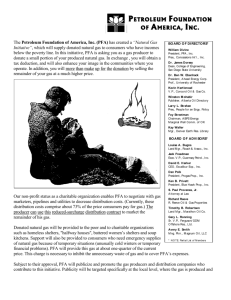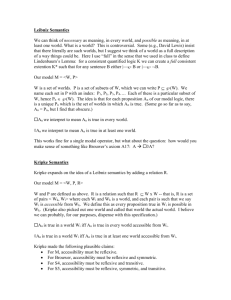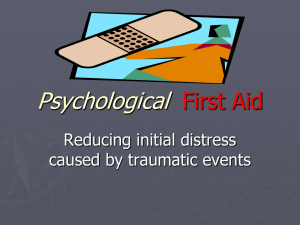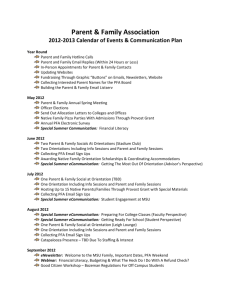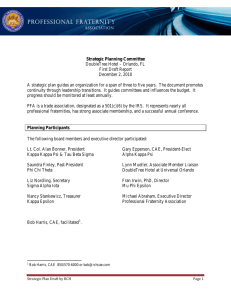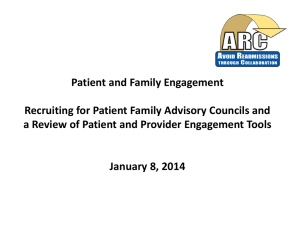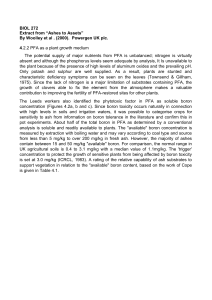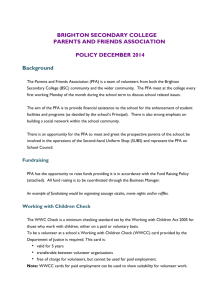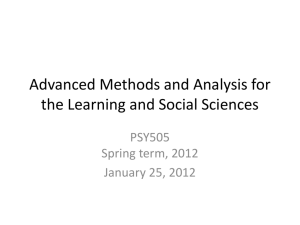Orientation to Mental Health & Psychosocial Support (MHPSS) for
advertisement
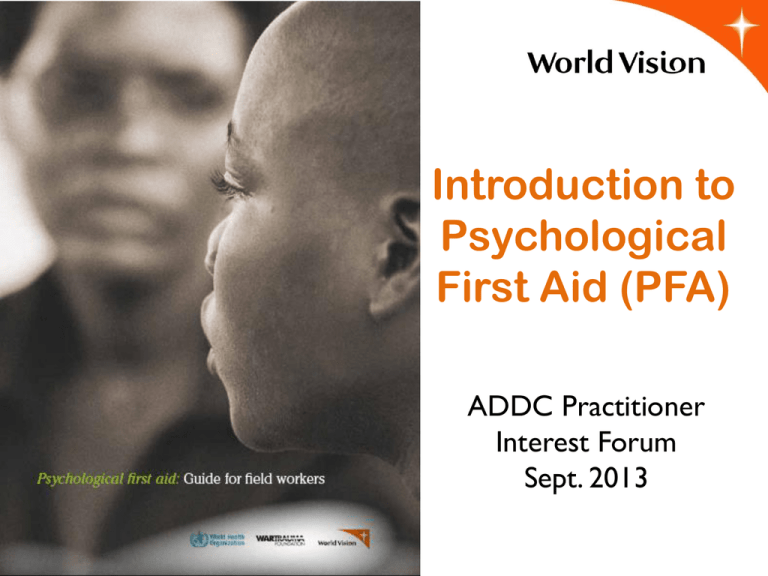
Introduction to Psychological First Aid (PFA) ADDC Practitioner Interest Forum Sept. 2013 The Psychological First Aid Field Guide Acknowledgements • Writing and Editorial Team - Leslie Snider (War Trauma Foundation, WTF), Mark van Ommeren (World Health Organization, WHO) and Alison Schafer (World Vision International, WVI). • Steering Group (alphabetical) - Stefan Germann (WVI), Erin Jones (WVI), Marieke Schouten (WTF), Shekhar Saxena (WHO), Alison Schafer (WVI), Leslie Snider (WTF), Mark van Ommeren (WHO). • Funding - World Vision International • Illustrator – Julie Smith, PD Consulting • In addition, we acknowledge the 27 anonymous respondents who participated in a • pre-consultation survey on the need to develop this document. Plus the many individuals and agencies who contributed to the peer review process. This guide will be formally endorsed by many member organisations of the IASC Mental Health and Psychosocial Support Reference Group, including ….. The Psychological First Aid Field Guide - Endorsements Group Discussion 1. What comes to mind when you think about “First Aid”? 2. What comes to mind when you think about “Psychological First Aid”? PFA is not.... • It is NOT something only professionals can do • It is NOT professional counseling • It is NOT a clinical or psychiatric intervention (although it can be part of good clinical care) • It is NOT psychological debriefing • It is NOT asking someone to analyze what happened to them or to put time and events in order • It is NOT pressing people to tell you their story • It is NOT asking people details about how they feel or what happened Psychological First Aid (PFA) is: A description of a humane, supportive response to a fellow human being who is suffering and who may need support. PFA involves the following themes: – Providing practical care and support that does not intrude – Assessing needs and concerns – Helping people to access basic needs (e.g. food and water, information) – Comforting people and helping them to feel calm – Helping people connect to information, services and social supports – Protecting people from further harm Based on Sphere (2011) & IASC MHPSS Guidelines (2007) Examples: The place of PFA in overall mental health Mental health care by mental and psychosocial response health specialists (psychiatric nurse, psychologist, psychiatrist etc) Basic mental health care by PHC doctors Basic emotional and practical support by community workers (Psychological First Aid) Specialised services Focused (person-toperson) non-specialised supports Activating social networks Communal traditional supports Community and family supports Strengthening community and Supportive child-friendly family supports spaces Advocacy for basic services that are safe, socially appropriate and protect dignity Basic services and security Social considerations in basic services and security Why PFA? • Following crises, people do better over the long-term if they… – Feel safe, connected to others, calm and hopeful – Have access to social, physical and emotional support – Feeling able to help themselves, as individuals and communities Who is PFA for? • PFA is for very distressed people who have been recently exposed to an extremely distressing event. • It can be provided to children and adults • Not everyone who experiences a crisis event will need or want PFA. Do not force help on people who do not want it • PFA is not necessarily for everybody Adapting to culture (& context) 1. What might be necessary to consider to adapt to culture? 2. What might be necessary to consider to adapt to context? What is covered in PFA Skills Training? • • • • • • • • Careful analysis of culture and context Ethical principles of PFA, including a number of do’s and don’ts Practicing of good and effective communication Preparing yourselves to provide PFA – practically and emotionally (e.g., self-care) A detailed overview of the Action Principles of PFA Consideration of people who may likely need more specialised care, such as vulnerable groups, children and adolescents, etc. How to provide PFA for children Lots and lots of role plays, simulations and communication exercises to develop SKILLS in PFA The Action Principles of PFA Principle Actions LOOK Check for safety. . Check for people with obvious urgent basic needs. Check for people with serious distress reactions. LISTEN Approach people who may need support. Ask about people’s needs and concerns. Listen to people, and help them to feel calm. LINK Help people address basic needs and access services. Help people cope with problems. Give information. Connect people with loved ones and social support. Examples of distress responses •Physical symptoms (e.g. Shaking, headaches, fatigue, loss of appetite, aches & pains) •Crying, sadness, depressed mood, grief •Anxiety, fear •Being “on guard” or “jumpy” •Being afraid that something really bad is going to happen •Insomnia, nightmares •Irritability, anger •Guilt, shame •Confused, emotionally numb, or feeling unreal or in a daze •Being immobile or withdrawn •Not responding to others, not speaking at all •Disorientation (not knowing one’s name, where they are from or what is happening) •Not being able to care for oneself or one’s children Helping people feel calm •Brief breathing exercise •Brief “tapping” exercise •Brief mindfulness exercise using items in the room Positive Coping Strategies •Getting rest •Easting as regularly as possible •Drinking plenty of water •Spending time with family & friends •Discuss problems with someone you trust •Do activities that help you relax – e.g. Walking, singing, praying, playing with children) •Engage in physical exercise •Find safe ways to help others Negative Coping Strategies •Taking drugs, smoking or drinking alcohol •Sleeping all day •Working all the time without any R&R •Isolating yourself from friends and loved ones •Neglecting basic personal hygiene •Violence Principle Actions LOOK . Check for safety. Check for people with obvious urgent basic needs. Check for people with serious distress reactions. LISTEN Approach people who may need support. Ask about people’s needs and concerns. Listen to people, and help them to feel calm. LINK Help people address basic needs and access services. Help people cope with problems. Give information. Connect people with loved ones and social support Questions?
